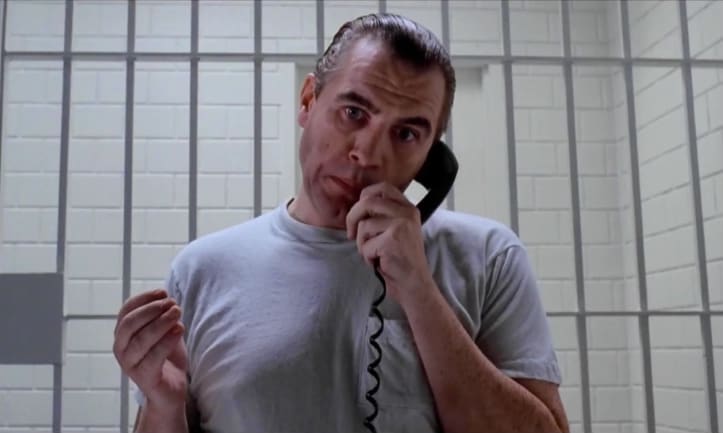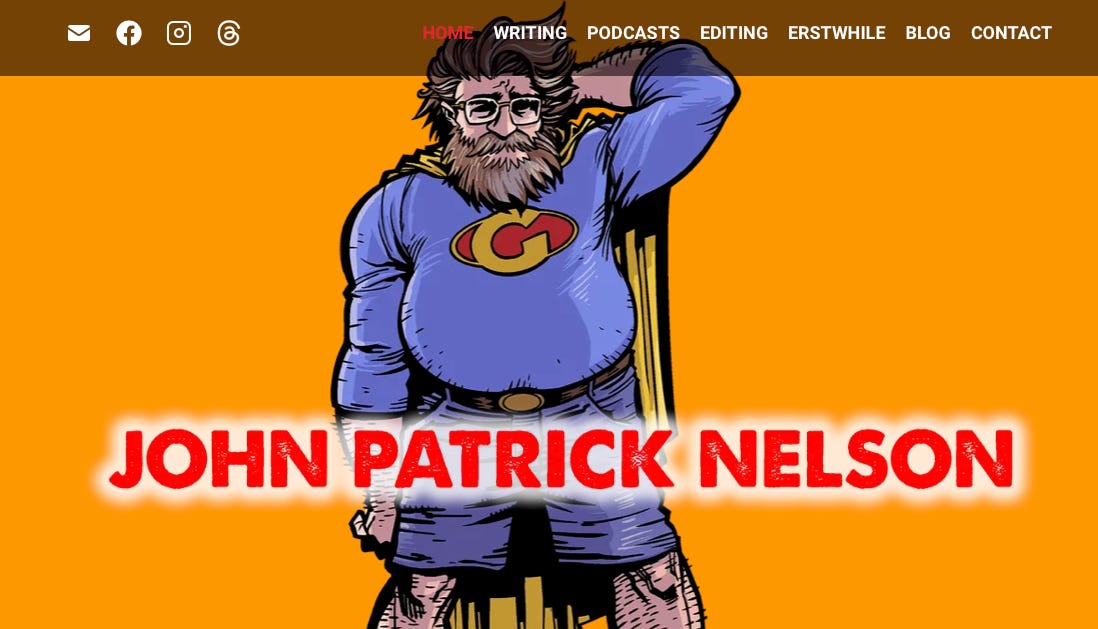The $#%& is Up With Michael Mann’s Jump Cuts?!
Right in the middle of a got damn take an' all
[This one goes out to the super-obsessive film geeks. Civilians, my apologies.]
Okay, see, I’m only writing this because I went looking for it online, and barely anybody talks about it. But once you see it, you can’t unsee it.
Michael Mann’s use of jump cuts.
What’s a jump cut? Well, there’s different kinds. The good kind, it’s when you use a “hard cut” to, among other things, jump forward (or backward) in time, to create a stylistic feel, without a transition (a fade out, a white flash, etc.). Here’s a couple good ones:
Those are clever uses of jump cuts. Same wide frame, but certain things in it shift around to show time passing.
Then there’s the jump cut I’m talking about, which is more like this:
You see them all the time in TikToks and YouTube videos. Somebody’s talking, camera on their face, then there’s an edit, and the camera hasn’t moved, but because people aren’t robots, they shift slightly (or greatly), so you can tell the edit was there. Some cut in the middle of sentences or even words. If you notice it, the effect can be jarring. It looks like a piece that’s supposed to be there is missing.
Ah, but do you “notice?” There’s the rub.
You actually see it every day, may have even become inured to it, because TikTokkers don’t bother to hide such things.
So, if you don’t notice it, you may be wondering, what’s the big brew-ha-ha?
Well, while you’re used to seeing it in personal videos and TikToks, believe me, if Batman started talking in jump cuts, you’d be thrown.
Most TV and movies, they take great pains not to break the reality of a moment.
And most directors would be horrified to have a noticeable jump cut in the middle of a take, centered directly on an actor’s face.
But not Michael Mann. He seems to welcome the challenge.
First time I saw it, I was watching “Manhunter,” the original Hannibal Lecktor1 movie. Camera’s right there, on his face, and BOOM, there was the cut, right in the damn middle of the scene. And it seemed like Mann tried to pass it off like, “What? No, you didn’t see that. Must’ve blinked.”
But I saw it. Oh, yes.
(In the link above, you’ll see it at about :51-:52. Watch his eyes.)
In the days of literal film prints, audiences were used to seeing unintended jump cuts more often. Prints would break and require emergency splicing, and the longer that print got passed around, the worse it would get. Here in L.A., at Quentin Tarantino’s movie theater, “The New Beverly Cinema,” they exclusively show film prints, just like the old days, and man, do you see that shit way more than you do in modern film projection.
So maybe Mann was counting on audiences of the time being used to seeing such things. Make a weakness a strength. As one of the filmmakers at the cutting edge of style at the time, he’d maybe be forgiven for running with them, when few others would risk it.
But Mann does the jump cut thing a lot. I’ve caught one in almost every movie or show he directs. There’s one in his HBO show “Tokyo Vice” that was particularly jarring. Though I think that one was on purpose. Because sometimes, the effect is deliberate, to unsettle, or tell the audience that something is wonky.
But the jump cuts I’m complaining about, they don’t feel like stylistic choices. They feel like solutions to a problem. Specifically, cutting two great actor takes together to make it look like a single, unbroken take.
Why is it necessary for a moment to be unbroken? You’d have to ask the individual filmmaker. I’m sure many would say an unbroken performance by an actor is a preferred goal. Keeps it real, keeps you involved, draws you in, a million different things.
Speaking of Hannibal, imagine Anthony Hopkins in “Silence of the Lambs,” his unblinking stare as he performs long monologues. The longer you can go without cutting away, the more unsettling it gets, the more dangerous Hannibal Lecter2 becomes. The audience begins to feel he’s staring out of the movie at them.
Creepy.
And this all depends on the actor nailing the performance, the silences, the everything. And that nothing technical goes wrong for the whole take.
Many times, if an actor doesn’t quite nail it in a single take, or there’s a technical foul, the editor or director will cut two amazing takes together - first half of take 1, second half of take 3 - and find a way to hide the edit in the middle, often with a cutaway shot - a shot of literally anything else - Jodi Foster, somebody else in the room, a dog, a book on a shelf, anything that can help keep the moment where it needs to be - then back to the actor. And it pretty much seems unbroken. It happens all the time.
And most times, it’s so well done, it has the illusion being a single take. There’s plenty of films I watch something I thought had an unbroken moment, only to discover, oh, there’s a cutaway shot in there.
But Mann apparently doesn’t want to use that cutaway shot. Maybe he doesn’t like them when he didn’t plan for them, maybe he just doesn’t have any footage he thinks will serve. Well, if he’s not gonna cover his edit, that means he’s got two different shots slammed together in the middle. And usually, even the most precise actors aren’t so precise that you can just cut two takes right together.
I mean, he gets close, credit where credit’s due.
Patching two different takes together ain’t as iffy as it used to be, thanks to computer editing and CGI. I’ve heard tales of movies from almost twenty years back, where they used CGI to hack several different takes together to create one apparently seamless take.
Yet, Mann seems to opt for a hard cut, without any digital smoothing, even to this day.
This is, by the way, a director who fiddles with his old films constantly. Every time it gets released to a new medium, VHS, laserdisc, DVD, blu-ray, 4K, Mann goes in the cutting room and makes adjustments. The “Heat” I saw in the theater in ‘95 doesn’t exist anymore, even in what’s called the “Theatrical Cut.” I wouldn’t be shocked to learn that Mann even changed the film during the original release.
So, if he wanted to smooth over them jump cuts, he probably could.
Meaning he chooses not to.
Why? Couldn’t tell ya.
How much does he use them? Few months back, I was watching “Collateral” on my sick bed, iPad propped on my stomach, and noticed one while Tom Cruise was monologuing in the back of a taxi. Saw it clear as day, probably because my face was two inches from the screen.
And it got me going down this rabbit hole. I watched Mann’s movies, one after another, and one after another, I caught stray jump cuts in the middle of actor’s faces.
How profligate is the jump cut in a Mann film?
I decided to rewatch “Manhunter” whilst I was writing this, since I thought I already knew where the jump cut was.
I hadn’t gotten half an hour in before I saw three others I hadn’t caught before.
He doesn’t use it as much in his modern pics. Probably for just the reason I pointed out, people can see the screens way better, and pick those jump cuts right out. I don’t think it’s a coincidence that I started noticing them on blu-rays and 4K TVs, and not on those fuzzy, vazaline-looking VHS tapes.
(Though, I saw “Manhunter” on the big screen recently, and the jumps are much easier to spot. I mean, when you’re lookin’ fer ‘em.)
Why am I so obsessed with this?
Well… I… because…
… I dunno.
Cuz yer not a’sposed to do it, I guess.
Because it seems a very rough solution to a very delicate problem. I mean, I’m not one’a them peoples that gives too much of a shit when filmmakers break the line, or cut to a black screen, or when they break filmmaking rules in general, just because, it’s art, we’re supposed to break the rules.
Other hand, rules should be broken with purpose. Even if it’s to say “fuck you, I don’t give a shit what you think, I really wanna do it, so I’m doing it.” Because this particular violation seems like the filmmaker cares very much what the audience thinks. He’s going for a specific reaction, and thinks this is the best way to get it. And he’s willing to risk getting caught doing it, though he seems to take pains to NOT have it be seen.
Thus, hard, HARD cuts, right in the middle of a take.
And to what purpose? Couldn’t tell you.
I am curious to see, with the advent of TikTok, and influencers self-editing, if movies and TV will eventually start using jump cuts more often, in this particular style, while the camera holds on an actor, and they’re monologuing. To me, that seems weird, but these things tend to evolve like the overused frog in the boiling water metaphor - one weird cut on one show, another weird cut in a movie, and then, in ten years, what was once frenetic, high-octane editing looks like old-timey black & white silent films.
You won’t see ME doing that. Y’know, in my many movies and TV shows that I for sure will be getting a chance to produce for big money.
STORIES…
Click the titles to read muh stories:
or you c’n find alla this right chere:
© MMXXV
Yeah, he spelled “Lector” with a “k.” Probably thought it sounded coooooooool.
That’s right, no “k,” cuz Hopkins don’t need it.






This is going to be one of those things I’m always going to be looking for now and won’t be able to unsee.
Morph cuts are getting bad now as well, using AI to try to make those jump cuts appear seamless, but since it’s AI it still can’t resist adding extra fingers or a third hand.